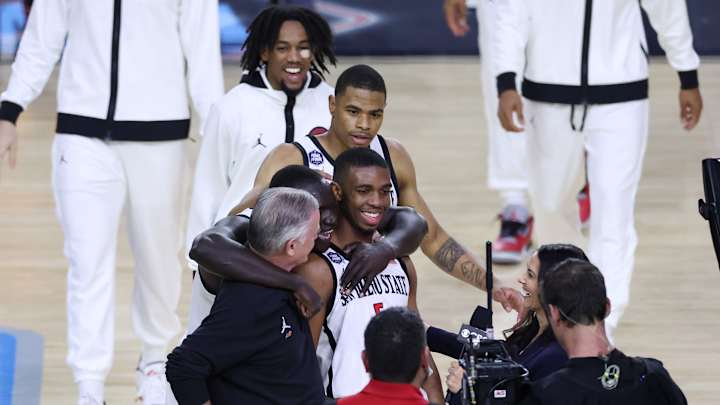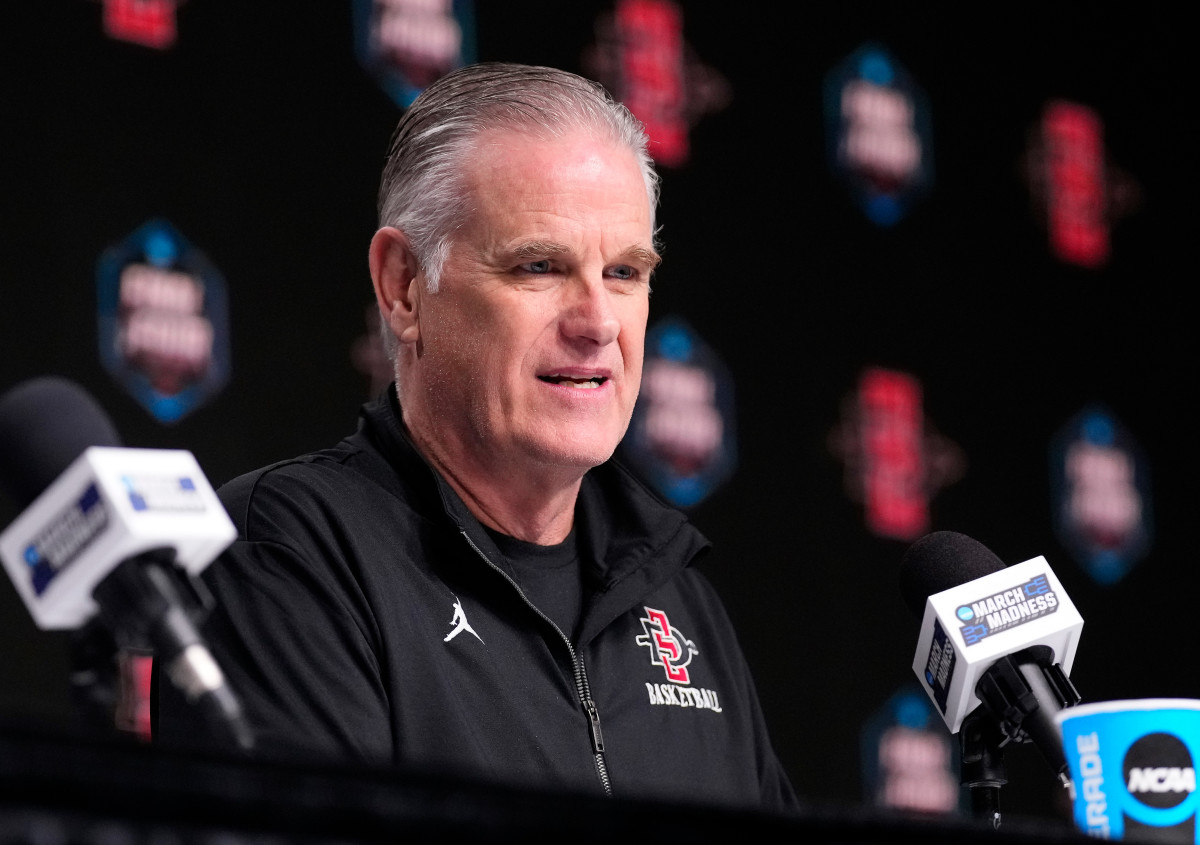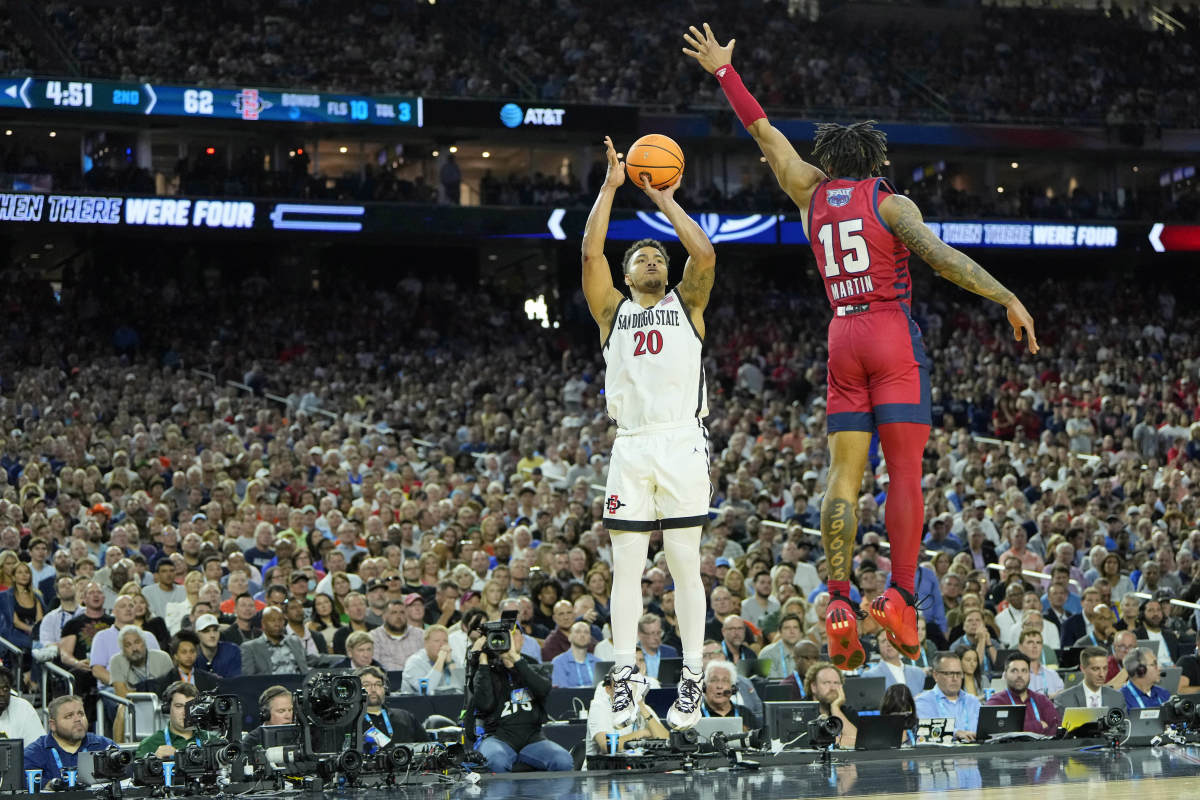San Diego State’s Title Run Completes Its Program Transformation

When Steve Fisher and his longtime right-hand man Brian Dutcher arrived at San Diego State in 1999, the two tried selling what seemed like an impossible dream to most casual observers: competing for national championships.
At the time, San Diego State was, well, ordinary in the grand scheme of college basketball. It had finished over .500 just once in the last decade, had its last 20-win season in 1985 and had never won an NCAA tournament game. Just two years before, the program had been splitting time between the cavernous San Diego Sports Arena 10 miles from campus and the tiny Peterson Gym back on campus, which seated under 4,000.
Fisher won a national championship (and went to two other national title games) as head coach at Michigan, but this was a different challenge. And yet 24 years after Fisher and Dutcher set out to build a program essentially from the ground up, San Diego State will play on college basketball’s biggest stage Monday for a chance at completing that impossible dream and winning a national title. The Aztecs have a chance to be the first West Coast team since Arizona in 1997 to win a national title, which could further cement the program’s status as a national powerhouse, something that would have seemed unthinkable just 25 years ago.
“We recruited and told people this is what we were going to do,” Dutcher said last week. “They all thought it was just recruiting talk, but here we sit.”
Arizona and UCLA had long been the two titans of college basketball out West, winning national titles in 1997 and ’95, respectively. But two hires made in ’99 at polar opposite programs changed the trajectory of the sport near the Pacific. Gonzaga, a new Cinderella after a surprise Elite Eight run, hired Mark Few to replace Dan Monson and ideally continue that upward trajectory. And San Diego State, in need of a spark after a four-win season, turned to Fisher, who needed someone to bet on him after being forced out in Ann Arbor in the aftermath of the Ed Martin scandal that caused Fisher’s Fab Five teams’ Final Four appearances to be stripped.
The story of Gonzaga’s unthinkable growth into a hoops power has been written at length. San Diego State’s story might not quite be as perfect a Cinderella tale, but those two programs’ parallel rises in the last 25 years (a 25 years without a UCLA or Arizona championship) has been remarkable. And now the Aztecs get a chance to complete the tale with a national title of its own, the lone achievement lacking for Gonzaga in this era of mid-major dominance out West.
Success wasn’t as immediate for the Aztecs as it was in Spokane, where Few immediately built on the Elite Eight run the previous year with a trip to the Sweet 16. Fisher and Dutcher, teamed up again after Dutcher had been Fisher’s associate head coach at Michigan, had a longer rebuild on hand with the Aztecs. They won just five games in their first season and 14 in year two, but that didn’t stop the Aztecs from dreaming big. The goal wasn’t just to contend for WAC championships, it was to contend nationally.
“From the day we stepped on campus Coach Fisher and I all those years ago, we thought it was a possibility,” Dutcher said Thursday. “We believed if we did what we were supposed to do, we could make a Final Four, we could win a national championship.”

It helped that the program was being invested in at a high level. Ditching the downtown Sports Arena for an on-campus home like the Viejas Center (then Cox Arena) helped in a big way, as did investment in athletic facilities generally. Major gifts from John Moores, the former owner of the San Diego Padres, helped the Aztecs build an athletic administration building, its baseball stadium named for Tony Gwynn (a former Aztec and Padre) and more.
But the best way to elevate an athletic program is winning over the long term. And that’s what the Fisher–Dutcher duo eventually did. The Aztecs went dancing for the first time under Fisher in 2002 and again in ’06, then they really took off. SDSU’s only season with fewer than 20 wins since that ’06 tournament appearance? Fisher’s last year before he retired in ’17, when his team went 19–14. San Diego State went dancing in six straight seasons starting in ’10, including a No. 2 seed and Sweet 16 appearance with Kawhi Leonard in ’11 and another trip to the second weekend with star guard Xavier Thames leading the way in ’14.
“Obviously [2023] is going to go down as the greatest team in San Diego State history. But there are other teams that were equal to this, if not maybe better in some areas,” Dutcher said Sunday. “The Kawhi Leonard team … that was an incredible team. We lost to UConn and Kemba Walker in the Sweet 16. That team was capable of winning it all. Sometimes you just have to have the right matchups, be playing your best basketball, get a break here or there.”
Fisher’s retirement in 2017 didn’t cause the program to miss a beat. Dutcher, who had resisted other openings in favor of eventually succeeding his long-time boss, had been named coach-in-waiting. (“I didn't want to sell insurance at some point in my life. I knew I better take a really good job when I got my first job,” Dutcher quips now.) He had to wait until after his 55th birthday to become a head coach, but once he did, he had the Aztecs winning and built arguably the best team in program history in the 2019–20 season.
WIth Washington State transfer guard Malachi Flynn leading the way, San Diego State started 26–0, topped out at No. 4 in the AP Poll and was trending towards a top-two seed in the NCAA tournament before the COVID-19 outbreak led to the Big Dance being canceled. Legitimate opportunities to chase a national championship for programs like San Diego State, no matter how much the brand had been elevated since Fisher and Dutcher had arrived, don’t come around often.

But there are still traces of that 2020 team everywhere in the DNA of this year’s Aztec team, the one just 40 minutes away from breaking through with a championship after missing perhaps its best chance ever just three years before. Four players on this year’s team (starting center Nathan Mensah, guard Adam Seiko and forwards Keshad Johnson) were on the 2020 Aztecs, and that ’20 team was also key in recruiting this current ’23 roster. Leading scorer Matt Bradley transferred in from Cal in ’21 after averaging 18 points per game in the Pac-12; San Diego State was able to recruit him by showing the success of Flynn, who had put up similar numbers on losing Washington State teams before being the missing piece in San Diego and getting drafted by the Toronto Raptors as a result.
“That was exactly what [the comparison] was,” Bradley says of his recruiting process.
When Arizona won its lone title in 1997, suggesting to anyone that the next title-winner out West might be middling San Diego State would have seemed ludicrous. But in a quarter-century, one of the greatest program transitions in the country has been brought to near-completion. The last thing San Diego State needed to complete its ascent from regional power to a national one was a run like this in the Big Dance. Before this tournament, the Aztecs had never made it past the Sweet 16. Even if they can’t come out on top Monday, this run has cemented San Diego State’s brand as more than just a consistently good team out West.
“We have a national perception now,” Dutcher said Sunday. “I think everybody out West has always known we’ve been good, but now that we're playing on the biggest stage, and we're winning on the biggest stage, I think a lot like when Gonzaga made that step, they did it on a national stage. And that's how they gained their respect. And hopefully this national stage will give us national respect.”
